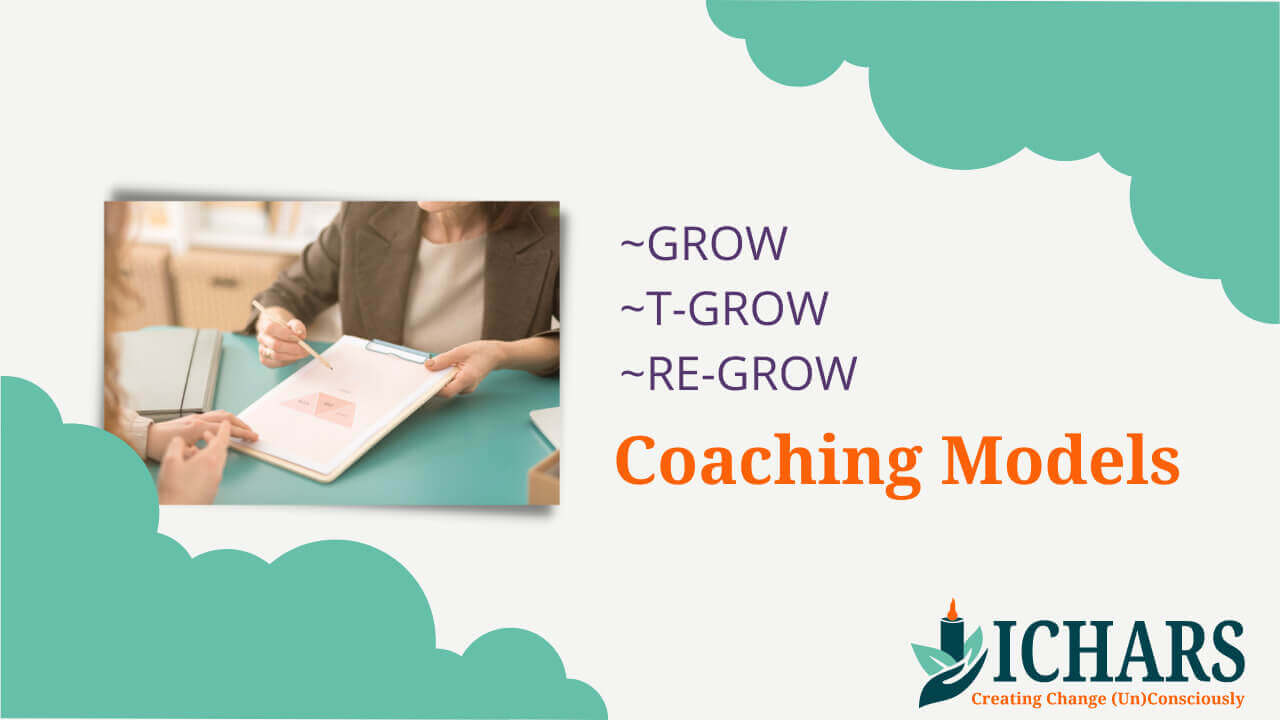A coaching model is a framework; it’s the underlying structure that you can use when you’re coaching someone. This structure consists of different components or steps.

Each component or step has an objective that allows you to ensure that the coaching session is systematic and does not spiral into a roundabout chat.
There are multiple coaching models but all of them are based on the primary understanding of what coaching is about.
GROW Coaching Model
Now that you know understand what is a coaching module and what is its purpose, let us explore the GROW coaching framework. Over the years this model has grown in popularity due to its broad scope of application, ease of use and effectiveness.
Each letter from GROW represents a step that the coach takes the one being coached through. GROW stands for
- Goal
- Reality
- Options
- Wrap up
Some schools use the expression “what next” while others use the word “Will”, instead of wrap up. But they are really speaking about the same thing.
Step 1: Goal Setting
The objective of the first step in the GROW coaching model is to help the client decide & get clarity about their goals. The questions that a coach asks the client include:
- What would you like to achieve as a result of this session?
- What would you like to get from the next 30 minutes?
- Describe your perfect world
The coach may also ask what is known as the “miracle question”
Suppose tonight, while you slept, a miracle occurred. When you awake tomorrow, what would be some of the things you would notice that would tell you that your life had suddenly gotten better?
Step 2: Reality Assessment
Once the client has clarity about his / her goals, the next step in the GROW Coaching Model is to help them explore and get an understanding of their current Reality. Questions that a coach asks a client include:
- On a scale of 1-10 where are you in relation to your goal?
- What has contributed to your success so far?
- What strategies have use used that have not worked for you?
- What skills do you already have that can help you achieve this outcome?
- What skills would you need to develop to achieve this outcome?
- What progress have you made so far?
- What is working well right now?
The coach may also explore if the chosen goal is in sync with other goals and objectives they have or not. The coach can ask a question like:
- Does this goal conflict with any other goals or objectives you have?
- What would you have to give up, to accomplish this goal?
- How would you make time to work towards this goal?
Step 3: Consider different options
Now that the client has an understanding of where they are and where they want to go, the next step focuses on helping the client consider the different options and ways that can help them reach where they want to. Here the Coach works with the client to brainstorm options, as well as possible actions that have already been taken. The questions that a coach asks the client includes:
- How have you tracked this or a similar situation before?
- What possible options do you have?
- Give me five options that can help you move closer to your goals?
- If anything was possible, what would you do?
- What else?
- What are the advantages and disadvantages of each option?
- What factors or considerations will you use to weigh the options?
- What do you need to stop doing in order to achieve this goal?
- What obstacles stand in your way?
Step 4: Wrap Up
Once each of the options has been considered and weighed with respect to other options, during the Wrap-up phase, the coach works with the client to help the client identify specific steps and obstacles, write an action plan and finally check for commitment to act on the specific actions that have been identified.
The questions that a coach asks during this step include:
- Which options work best for you?
- What one small step are you going to take now?
- What actions will you take?
- When are you going to start?
- Who will help you?
- How will you know you have been successful?
- How will you ensure you do it?
- What could stop you moving forward? How will you overcome this?
- On a scale of 1-10, how committed and motivated are you to doing it?
Once the client gives a commitment, the session would generally come to an end.
With each session, the client’s reality begins to change as they start moving towards their goals. This process is followed by the coach and the client in each session which helps the client move towards their goals in a systematic and effective manner.
Case Study: Sarah’s Public Speaking Improvement
- Sarah’s Goal: Confidently deliver a 30-minute presentation to her team in three months.
- Reality: Sarah rates her public speaking skills as a 4 out of 10. She has attended workshops but feels they haven’t helped much.
- Options: Joining a public speaking club, hiring a speech coach, practicing in front of friends, and recording her speeches to self-review.
- Wrap-Up: Sarah decides to join a public speaking club and practice weekly, starting immediately. Her coach and a friend will support her.
Evolution of GROW Coaching Model
Over a period of time with more and more coaches using GROW Model, there were certain areas of improvement that were identified in the GROW Model. This lead to the evolution of the GROW Model into what is known as the T-GROW and the RE-GROW Coaching Models.
T-GROW Coaching Model
The letter “T” in the T grow model is an acronym for Topic.
The idea behind T-GROW model was that at times clients come with multiple problems or topics and they try to talk about all of those problems or topics in the same session. This would lead to a collection of information in a very unsystematic and haphazard way which could create more confusion than clarity.
So as a way to ensure that the session is more planned and the collected information is systematic enough to create clarity, a coach will first begin by asking the client to identify a particular problem or a particular topic that they would like to work with. Once the client identifies that topic the session will revolve around that particular problem or topic and the standard GROW model will be applied.
In the case of multiple problems or topics, each problem or topic would be considered and approached as a different coaching assignment.
Case Study: Alex’s Career and Health Balance
- Topic Selection: Alex wants to address both his career growth and health improvement, but feels overwhelmed handling both.
- Goal: Prioritize his career goal of getting a promotion and a health goal of losing 10 pounds in the next six months.
- Reality: Alex is doing well in his job but lacks time for exercise, rating his current health efforts as 3 out of 10.
- Options: Delegating work, setting specific work hours, hiring a personal trainer, meal prepping, and scheduling workout times.
- Wrap-Up: Alex decides to focus on career goals during weekdays and health goals on weekends. He will delegate more tasks at work and hire a personal trainer.
RE-GROW Coaching Model
Now that you understand the T-GROW model, let us quickly look at the RE-GROW model of Coaching.
The letters “R” and “E” in the RE-GROW model stand for Review and Evaluate.
The idea behind this model was that a coaching assignment doesn’t end in one session. There are multiple sessions required to help the client achieve their desired outcome.
Hence in every subsequent session, before we use the GROW model, we need to review and evaluate the impact of the previous session. In short, when we add Review and Evaluation to GROW model, it becomes RE-GROW Model.
Case Study: Mia’s Business Expansion
- Review and Evaluate: Mia had previously set a goal to expand her business by opening a new branch, but progress has stalled. Review reveals issues with location scouting and staffing.
- Goal: Successfully open a new branch in the next quarter.
- Reality: Mia has scouted locations but hasn’t found a suitable one. Staffing plans are incomplete.
- Options: Hiring a real estate consultant, attending business networking events, running recruitment drives, and improving existing staff training.
- Wrap-Up: Mia decides to hire a real estate consultant and start a recruitment drive immediately. She will review progress in two weeks with her coach.
Practical Applications and Case Studies
By illustrating these models with practical examples, coaches can see how to apply the steps systematically to achieve effective outcomes. Each model offers a structured approach to tackle different coaching scenarios, ensuring clarity and progress.
Conclusion
The GROW, T-GROW, and RE-GROW Coaching Models provide a systematic framework for effective coaching. By continuously evolving these models, coaches can address the unique needs of their clients, leading to better outcomes and greater clarity.
Further Learning
If you would like to learn advanced Coaching Models and use them in combination with Hypnosis, NLP, and other change processes, join us for the Cognitive Hypnotic Coaching Diploma.

